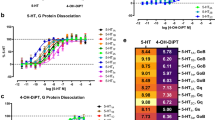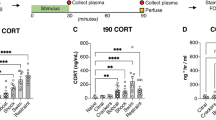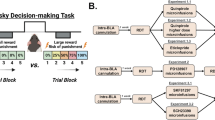Abstract
Central among the brain regions that regulate fear/anxiety behaviors is the lateral/basolateral amygdala (BLA). BLA output is tightly controlled by the relative activity of two populations of inhibitory GABAergic interneurons, local feedback cells distributed throughout the nucleus, and feedforward cells found along the lateral paracapsular border of this subdivision. Recent studies suggest that dopamine (DA) can modulate the BLA GABAergic system, thus linking fear/anxiety states with mesolimbic reward/attentional processes. However, the precise dopaminergic mechanisms regulating the activity of the two BLA GABAergic neuron populations have not been fully explored. We therefore examined the effects of DA D3-like receptors on BLA-dependent anxiety-like behavior and neurophysiology. After confirming the presence of D3-like receptors within the BLA, we found that microinjection of a D3-selective antagonist into the BLA decreased anxiety-like behavior expressed in both the light/dark transition test and the elevated plus maze. Consistent with this, we found that in vitro D3-like receptor activation selectively inhibits synaptic transmission at both BLA feedback and feedforward GABAergic interneuron populations, with no effect on glutamatergic transmission. This inhibition of GABAergic transmission is a result of a D3-like receptor-mediated, dynamin-dependent process that presumably reflects endocytosis of postsynaptic GABAA receptors found on principal BLA neurons. Because environmental cues alter both DA release and relative activity states of the BLA, our data strongly suggest that DA, potentially acting through D3-like receptors, may suppress the relative contribution by inhibitory processes in the BLA and modify the expression of BLA-related behaviors.
Similar content being viewed by others
Log in or create a free account to read this content
Gain free access to this article, as well as selected content from this journal and more on nature.com
or
References
Audinot V, Newman-Tancredi A, Gobert A, Rivet JM, Brocco M, Lejeune F et al (1998). A comparative in vitro and in vivo pharmacological characterization of the novel dopamine D3 receptor antagonists (+)-S 14297, nafadotride, GR 103,691 and U 99194. J Pharmacol Exp Ther 287: 187–197.
Berglind WJ, Case JM, Parker MP, Fuchs RA, See RE (2006). Dopamine D1 or D2 receptor antagonism within the basolateral amygdala differentially alters the acquisition of cocaine-cue associations necessary for cue-induced reinstatement of cocaine-seeking. Neuroscience 137: 699–706.
Bissiere S, Humeau Y, Luthi A (2003). Dopamine gates LTP induction in lateral amygdala by suppressing feedforward inhibition. Nat Neurosci 6: 587–592.
Camacho-Ochoa M, Walker EL, Evans DL, Piercey MF (1995). Rat brain binding sites for pramipexole, a clinically useful D3-preferring dopamine agonist. Neurosci Lett 196: 97–100.
Carter DA, Fibiger HC (1977). Ascending projections of presumed dopamine-containing neurons in the ventral tegmentum of the rat as demonstrated by horseradish peroxidase. Neuroscience 2: 569–576.
Chen G, Kittler JT, Moss SJ, Yan Z (2006). Dopamine D3 receptors regulate GABAA receptor function through a phospho-dependent endocytosis mechanism in nucleus accumbens. J Neurosci 26: 2513–2521.
Davis M (2000). The role of the amygdala in conditioned and unconditioned fear and anxiety. In: Aggleton JP (ed). The Amygdala: A Functional Analysis. Oxford Press: New York. pp 213–288.
de la Mora MP, Cardenas-Cachon L, Vazquez-Garcia M, Crespo-Ramirez M, Jacobsen K, Hoistad M et al (2005). Anxiolytic effects of intra-amygdaloid injection of the D1 antagonist SCH23390 in the rat. Neurosci Lett 377: 101–105.
Di Ciano P (2008). Drug seeking under a second-order schedule of reinforcement depends on dopamine D3 receptors in the basolateral amygdala. Behav Neurosci 122: 129–139.
DuBois DW, Perlegas A, Floyd DW, Weiner JL, McCool BA (2006). Distinct functional characteristics of the lateral/basolateral amygdala GABAergic system in C57BL/6J and DBA/2J mice. J Pharmacol Exp Ther 318: 629–640.
Faber ES, Callister RJ, Sah P (2001). Morphological and electrophysiological properties of principal neurons in the rat lateral amygdala in vitro. J Neurophysiol 85: 714–723.
Finckh U, Rommelspacher H, Kuhn S, Dufeu P, Otto G, Heinz A et al (1997). Influence of the dopamine D2 receptor (DRD2) genotype on neuroadaptive effects of alcohol and the clinical outcome of alcoholism. Pharmacogenetics 7: 271–281.
Fuxe K, Jacobsen KX, Hoistad M, Tinner B, Jansson A, Staines WA et al (2003). The dopamine D1 receptor-rich main and paracapsular intercalated nerve cell groups of the rat amygdala: relationship to the dopamine innervation. Neuroscience 119: 733–746.
Grabs D, Slepnev VI, Songyang Z, David C, Lynch M, Cantley LC et al (1997). The SH3 domain of amphiphysin binds the proline-rich domain of dynamin at a single site that defines a new SH3 binding consensus sequence. J Biol Chem 272: 13419–13425.
Gremel CM, Cunningham CL (2009). Involvement of amygdala dopamine and nucleus accumbens NMDA receptors in ethanol-seeking behavior in mice. Neuropsychopharmacology 34: 1443–1453.
Guitart-Masip M, Johansson B, Fernandez-Teruel A, Canete T, Tobena A, Terenius L et al (2006). Divergent anatomical pattern of D1 and D3 binding and dopamine- and cyclic AMP-regulated phosphoprotein of 32 kDa mRNA expression in the Roman rat strains: implications for drug addiction. Neuroscience 142: 1231–1243.
Hammad H, Wagner JJ (2006). Dopamine-mediated disinhibition in the CA1 region of rat hippocampus via D3 receptor activation. J Pharmacol Exp Ther 316: 113–120.
Higley JD, Suomi SJ, Linnoila M (1991). CSF monoamine metabolite concentrations vary according to age, rearing, and sex, and are influenced by the stressor of social separation in rhesus monkeys. Psychopharmacology (Berl) 103: 551–556.
Inglis FM, Moghaddam B (1999). Dopaminergic innervation of the amygdala is highly responsive to stress. J Neurochem 72: 1088–1094.
Isoardi NA, Bertotto ME, Martijena ID, Molina VA, Carrer HF (2007). Lack of feedback inhibition on rat basolateral amygdala following stress or withdrawal from sedative-hypnotic drugs. Eur J Neurosci 26: 1036–1044.
Jones SR, Mickelson GE, Collins LB, Kawagoe KT, Wightman RM (1994). Interference by pH and Ca2+ ions during measurements of catecholamine release in slices of rat amygdala with fast-scan cyclic voltammetry. J Neurosci Methods 52: 1–10.
Kienast T, Hariri AR, Schlagenhauf F, Wrase J, Sterzer P, Buchholz HG et al (2008). Dopamine in amygdala gates limbic processing of aversive stimuli in humans. Nat Neurosci 11: 1381–1382.
Kittler JT, Delmas P, Jovanovic JN, Brown DA, Smart TG, Moss SJ (2000). Constitutive endocytosis of GABAA receptors by an association with the adaptin AP2 complex modulates inhibitory synaptic currents in hippocampal neurons. J Neurosci 20: 7972–7977.
Kroner S, Rosenkranz JA, Grace AA, Barrionuevo G (2005). Dopamine modulates excitability of basolateral amygdala neurons in vitro. J Neurophysiol 93: 1598–1610.
Lack AK, Diaz MR, Chappell A, DuBois DW, McCool BA (2007). Chronic ethanol and withdrawal differentially modulate pre- and postsynaptic function at glutamatergic synapses in rat basolateral amygdala. J Neurophysiol 98: 3185–3196.
Le Foll B, Goldberg SR, Sokoloff P (2005). The dopamine D3 receptor and drug dependence: effects on reward or beyond? Neuropharmacology 49: 525–541.
Marowsky A, Yanagawa Y, Obata K, Vogt KE (2005). A specialized subclass of interneurons mediates dopaminergic facilitation of amygdala function. Neuron 48: 1025–1037.
Matthews K, Dalley JW, Matthews C, Tsai TH, Robbins TW (2001). Periodic maternal separation of neonatal rats produces region- and gender-specific effects on biogenic amine content in postmortem adult brain. Synapse 40: 1–10.
McCool BA, Frye GD, Pulido MD, Botting SK (2003). Effects of chronic ethanol consumption on rat GABA(A) and strychnine-sensitive glycine receptors expressed by lateral/basolateral amygdala neurons. Brain Res 963: 165–177.
McDonald AJ, Betette RL (2001). Parvalbumin-containing neurons in the rat basolateral amygdala: morphology and co-localization of Calbindin-D(28k). Neuroscience 102: 413–425.
McDonald AJ, Mascagni F, Mania I, Rainnie DG (2005). Evidence for a perisomatic innervation of parvalbumin-containing interneurons by individual pyramidal cells in the basolateral amygdala. Brain Res 1035: 32–40.
Muller JF, Mascagni F, McDonald AJ (2007). Postsynaptic targets of somatostatin-containing interneurons in the rat basolateral amygdala. J Comp Neurol 500: 513–529.
Muller JF, Mascagni F, McDonald AJ (2009). Dopaminergic innervation of pyramidal cells in the rat basolateral amygdala. Brain Struct Funct 213: 275–288.
Nath C, Saxena RC, Gupta MB (2000). Effect of dopamine agonists and antagonists on the lorazepam withdrawal syndrome in rats. Clin Exp Pharmacol Physiol 27: 167–171.
Paxinos G, Watson C (1997). The Rat Brain in Stereotaxic Coordinates, 3rd edn. Academic Press: London, 80pp.
Pellow S, Chopin P, File SE, Briley M (1985). Validation of open:closed arm entries in an elevated plus-maze as a measure of anxiety in the rat. J Neurosci Methods 14: 149–167.
Phillips GD, Harmer CJ, Hitchcott PK (2002). Blockade of sensitisation-induced facilitation of appetitive conditioning by post-session intra-amygdala nafadotride. BehavBrain Res 134: 249–257.
Pinard CR, Muller JF, Mascagni F, McDonald AJ (2008). Dopaminergic innervation of interneurons in the rat basolateral amygdala. Neuroscience 157: 850–863.
Pitkanen A, Savander V, LeDoux JE (1997). Organization of intra-amygdaloid circuitries in the rat: an emerging framework for understanding functions of the amygdala. Trends Neurosci 20: 517–523.
Ramanathan S, Tkatch T, Atherton JF, Wilson CJ, Bevan MD (2008). D2-like dopamine receptors modulate SKCa channel function in subthalamic nucleus neurons through inhibition of Cav2.2 channels. J Neurophysiol 99: 442–459.
Sanders SK, Shekhar A (1995). Regulation of anxiety by GABAA receptors in the rat amygdala. Pharmacol Biochem Behav 52: 701–706.
Schiess MC, Asprodini EK, Rainnie DG, Shinnick-Gallagher P (1993). The central nucleus of the rat amygdala: in vitro intracellular recordings. Brain Res 604: 283–297.
See RE, Kruzich PJ, Grimm JW (2001). Dopamine, but not glutamate, receptor blockade in the basolateral amygdala attenuates conditioned reward in a rat model of relapse to cocaine-seeking behavior. Psychopharmacology (Berl) 154: 301–310.
Silberman Y, Ariwodola OJ, Chappell AM, Yorgason JT, Weiner JL (2010). Lateral paracapsular GABAergic synapses in the basolateral amygdala contribute to the anxiolytic effects of beta 3 adrenoceptor activation. Neuropsychopharmacology 35: 1886–1896.
Silberman Y, Ariwodola OJ, Weiner JL (2009). Differential effects of GABAB autoreceptor activation on ethanol potentiation of local and lateral paracapsular GABAergic synapses in the rat basolateral amygdala. Neuropharmacology 56: 886–895.
Silberman Y, Shi L, Brunso-Bechtold JK, Weiner JL (2008). Distinct mechanisms of ethanol potentiation of local and paracapsular GABAergic synapses in the rat basolateral amygdala. J Pharmacol Exp Ther 324: 251–260.
Steiner H, Fuchs S, Accili D (1997). D3 dopamine receptor-deficient mouse: evidence for reduced anxiety. Physiol Behav 63: 137–141.
Swant J, Stramiello M, Wagner JJ (2008). Postsynaptic dopamine D3 receptor modulation of evoked IPSCs via GABA(A) receptor endocytosis in rat hippocampus. Hippocampus 18: 492–502.
Szinyei C, Heinbockel T, Montagne J, Pape HC (2000). Putative cortical and thalamic inputs elicit convergent excitation in a population of GABAergic interneurons of the lateral amygdala. J Neurosci 20: 8909–8915.
Talalaenko AN, Abramets IA, Stakhovskii Yu V, Shekhovtsov AA, Chernikov AV, Shevchenko SL (1994). The role of dopaminergic mechanisms on the brain in various models of anxious states. Neurosci Behav Physiol 24: 284–288.
Vengeliene V, Leonardi-Essmann F, Perreau-Lenz S, Gebicke-Haerter P, Drescher K, Gross G et al (2006). The dopamine D3 receptor plays an essential role in alcohol-seeking and relapse. FASEB J 20: 2223–2233.
Washburn MS, Moises HC (1992). Electrophysiological and morphological properties of rat basolateral amygdaloid neurons in vitro. J Neurosci 12: 4066–4079.
Weiner JL, Gu C, Dunwiddie TV (1997). Differential ethanol sensitivity of subpopulations of GABAA synapses onto rat hippocampal CA1 pyramidal neurons. J Neurophysiol 77: 1306–1312.
Weiss F, Ciccocioppo R, Parsons LH, Katner S, Liu X, Zorrilla EP et al (2001). Compulsive drug-seeking behavior and relapse. Neuroadaptation, stress, and conditioning factors. Ann N Y Acad Sci 937: 1–26.
Woodruff AR, Monyer H, Sah P (2006). GABAergic excitation in the basolateral amygdala. J Neurosci 26: 11881–11887.
Wu PH, Poelchen W, Proctor WR (2005). Differential GABAB receptor modulation of ethanol effects on GABA(A) synaptic activity in hippocampal CA1 neurons. J Pharmacol Exp Ther 312: 1082–1089.
Xiang Z, Huguenard JR, Prince DA (2002). Synaptic inhibition of pyramidal cells evoked by different interneuronal subtypes in layer v of rat visual cortex. J Neurophysiol 88: 740–750.
Yang XM, Gorman AL, Dunn AJ, Goeders NE (1992). Anxiogenic effects of acute and chronic cocaine administration: neurochemical and behavioral studies. Pharmacol Biochem Behav 41: 643–650.
Yokoyama M, Suzuki E, Sato T, Maruta S, Watanabe S, Miyaoka H (2005). Amygdalic levels of dopamine and serotonin rise upon exposure to conditioned fear stress without elevation of glutamate. Neurosci Lett 379: 37–41.
Acknowledgements
We thank the assistance of Drs Jeff Weiner and Sara Jones for their advice and helpful discussions. This work was funded by National Institutes of Health/National Institute on Alcohol Abuse and Alcoholism Grants R01 AA01445, U01 AA016671, P01 AA017056, and F31 AA017576 (MRD).
Author information
Authors and Affiliations
Corresponding author
Ethics declarations
Competing interests
The authors declare no conflict of interest.
Rights and permissions
About this article
Cite this article
Diaz, M., Chappell, A., Christian, D. et al. Dopamine D3-Like Receptors Modulate Anxiety-Like Behavior and Regulate GABAergic Transmission in the Rat Lateral/Basolateral Amygdala. Neuropsychopharmacol 36, 1090–1103 (2011). https://doi.org/10.1038/npp.2010.246
Received:
Revised:
Accepted:
Published:
Issue date:
DOI: https://doi.org/10.1038/npp.2010.246
Keywords
This article is cited by
-
Elevated circulating adiponectin levels do not prevent anxiety-like behavior in a PCOS-like mouse model
Scientific Reports (2024)
-
Electroacupuncture Alleviates Anxiety-Like Behaviors Induced by Chronic Neuropathic Pain via Regulating Different Dopamine Receptors of the Basolateral Amygdala
Molecular Neurobiology (2022)
-
Cariprazine alleviates core behavioral deficits in the prenatal valproic acid exposure model of autism spectrum disorder
Psychopharmacology (2021)
-
Dopamine: from prediction error to psychotherapy
Translational Psychiatry (2020)
-
Activation of LXRβ Signaling in the Amygdala Confers Anxiolytic Effects Through Rebalancing Excitatory and Inhibitory Neurotransmission upon Acute Stress
Neurotherapeutics (2020)



